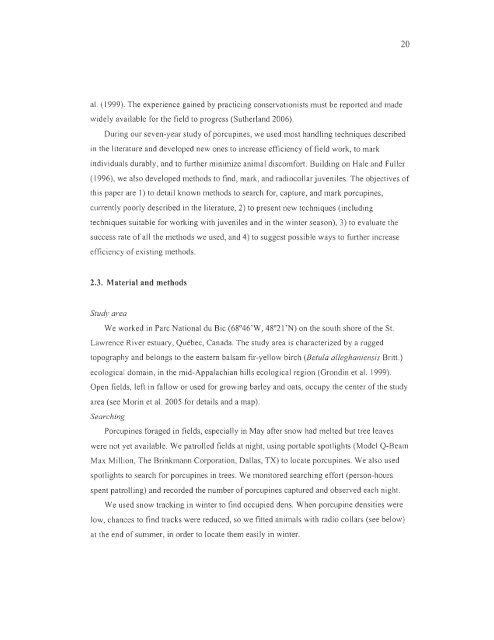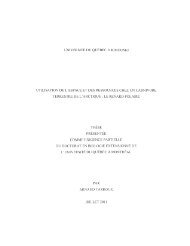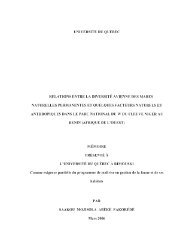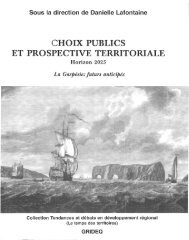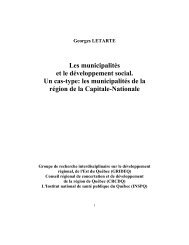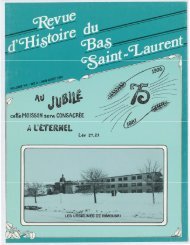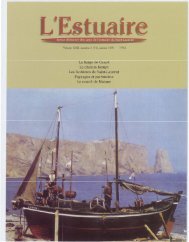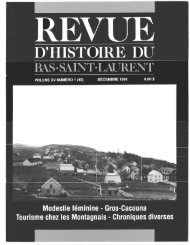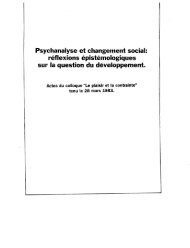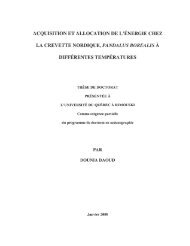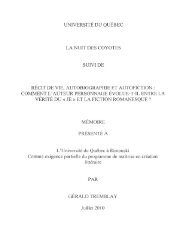influence du climat et de la prédation sur l'utilisation de l'habitat et la ...
influence du climat et de la prédation sur l'utilisation de l'habitat et la ...
influence du climat et de la prédation sur l'utilisation de l'habitat et la ...
You also want an ePaper? Increase the reach of your titles
YUMPU automatically turns print PDFs into web optimized ePapers that Google loves.
20<br />
al. ( 1999). The experience gained by practicing conservationists must be repo11ed and ma<strong>de</strong><br />
wi<strong>de</strong>1y avai<strong>la</strong>ble for the field to progress (Suther<strong>la</strong>nd 2006).<br />
During our seven-year study of porcupines, we used most handling techniques <strong>de</strong>scribed<br />
in the literature and <strong>de</strong>veloped new ones to increase efficiency of field work, to mark<br />
indivi<strong>du</strong>als <strong>du</strong>rably, and to fUl1her minimize animal discomfort. Building on Hale and Fuller<br />
(1996), we also <strong>de</strong>veloped m<strong>et</strong>hods to find, mark, and radiocol<strong>la</strong>r juveniles. The objectives of<br />
this paper are 1) to d<strong>et</strong>ail known m<strong>et</strong>hods to search for, capture, and mark porcupines,<br />
currently poorly <strong>de</strong>scribed in the literature, 2) to present new techniques (including<br />
techniques suitable for working with juveniles and in the winter season), 3) to evaluate the<br />
success rate of aIl the m<strong>et</strong>hods we used, and 4) to suggest possible ways to fUlther increase<br />
efficiency of existing m<strong>et</strong>hods.<br />
2.3. Material and m<strong>et</strong>hods<br />
Studyarea<br />
We worked in Parc National <strong>du</strong> Bic (68°46'W, 48°21 'N) on the south shore of the St.<br />
Lawrence River estuary, Québec, Canada. The study area is characterized by a rugged<br />
topography and belongs to the eastern bals am fir-yellow birch (B<strong>et</strong>u<strong>la</strong> alleghaniensis Britt.)<br />
ecological domain, in the mid-Appa<strong>la</strong>chian hills ecological region (Grondin <strong>et</strong> al. 1999).<br />
Open fields, left in fallow or used for growing barley and oats, occupy the center of the study<br />
area (see Morin <strong>et</strong> al. 2005 for d<strong>et</strong>ails and a map).<br />
Sem'ching<br />
Porcupines foraged in fields, especially in May after snow had melted but tree leaves<br />
were not y<strong>et</strong> avai<strong>la</strong>ble. We patrolled fields at night, using portable spotlights (Mo<strong>de</strong>l Q-Beam<br />
Max Million, The Brinkmann Corporation, Dal<strong>la</strong>s, TX) to locate porcupines. We also used<br />
spotlights to search for porcupines in trees. We monitored searching effort (person-hours<br />
spent patrolling) and recor<strong>de</strong>d the number of porcupines captured and observed each ni ght.<br />
We used snow tracking in winter to find occupied <strong>de</strong>ns. When porcupine <strong>de</strong>nsities were<br />
low, chances to find tracks were re<strong>du</strong>ced, so we fitted animais with radio col<strong>la</strong>rs (see below)<br />
at the end of summer, in or<strong>de</strong>r to locate them easily in winter.


